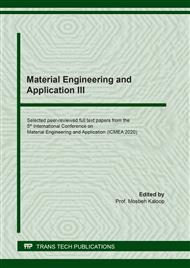p.1
p.7
p.13
p.19
p.25
p.31
p.39
p.45
Effect of Carbon Synthesized from Durian Bark on Properties of Natural Rubber Composite Foam
Abstract:
Natural rubber foam is used in industries as a gasket and insulation product. Dimensional expansion of specimen is the crucial problem of rubber foam specimen, especially in the automotive parts assembly. This work aims to understand the behavior of natural rubber foam (NRF)/carbon composites on microstructure and properties of NRF before being used. Carbon was synthesized from durian bark which was the agricultural waste that had the potential for using as reinforcing filler. The result showed the fast sulfur vulcanization rate with small bubble size at high amount of carbon. In addition, the young modulus of NRF/carbon composites increased with increasing carbon content.
Info:
Periodical:
Pages:
13-18
Citation:
Online since:
February 2021
Price:
Сopyright:
© 2021 Trans Tech Publications Ltd. All Rights Reserved
Share:
Citation:


